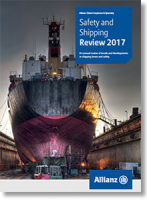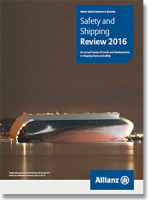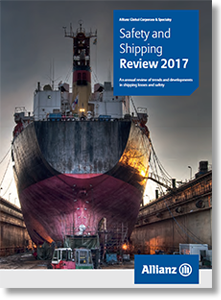Safety & Shipping Review 2017
This review focuses on key developments in maritime safety and analyzes shipping losses (of over 100 gross tons) during the 12 months prior to December 31, 2016. It also identifies some of key risk management challenges the industry faces moving forward.
International shipping transports approximately 90% of world trade, so the safety of vessels is critical to the global economy.
The maritime industry saw the number of total shipping losses decline during 2016 to 85.
The number of shipping incidents (casualties) also declined year-on-year.
Shipping losses declined by 16% compared with a year earlier (101).
The preliminary figures for the accident year show a significant improvement on the 10-year loss average (119) – down 29%.
Large shipping losses have also declined by 50% over the past decade, driven by improved regulation and the development of a more robust safety culture.
However, disparities by region and vessel type remain. The recent downturn in the shipping economy could also be a factor in benign loss activity.
More than a quarter of losses in 2016 (23) occurred in the South China, Indochina, Indonesia and Philippines maritime region, which has been the top loss hotspot for a decade.
While losses in this region remain stable year-on-year, the total is still almost double that of the next highest loss region – East Mediterranean and Black Sea (12).
Losses are up year-on-year in the following maritime regions: Japan, Korea and North China; East African Coast; South Atlantic and East Coast South America; and the Canadian Arctic and Alaska.
Cargo vessels (30) account for more than a third of 2016’s losses. Passenger ferry losses are up year-on-year (8), driven by activity in South East Asia and the Mediterranean.
Foundered (sunk/submerged) is the most common cause of all vessel losses, accounting for over half, often driven by bad weather. The number of losses resulting from fire/explosion (8) is up slightly year-on-year.
There were 2,611 reported shipping casualties during 2016, down 4%. Machinery damage/engine failure is the main cause and was also responsible for driving a 16% increase in the top hotspot – the East Mediterranean & Black Sea region.
Other topics covered
- Growing complexity and interconnectivity of shipping risk
- The collapse of Hanjin Shipping
- Piracy threat evolving as crew kidnappings rise
- Technology is driving safety improvements but overreliance is a concern
- The cyber threat at sea grows
- The development of autonomous shipping
What’s Related


Favorites





